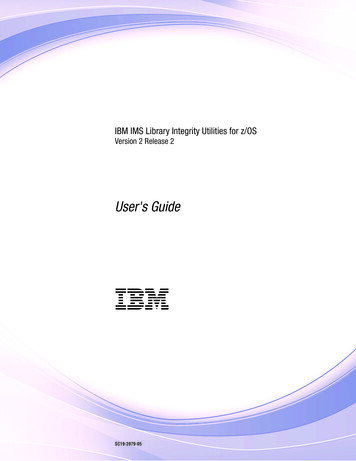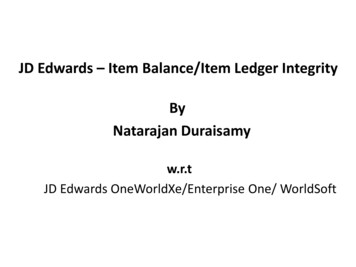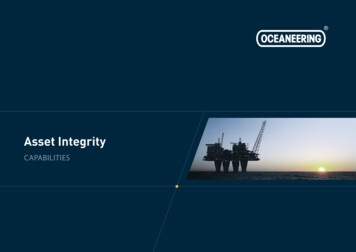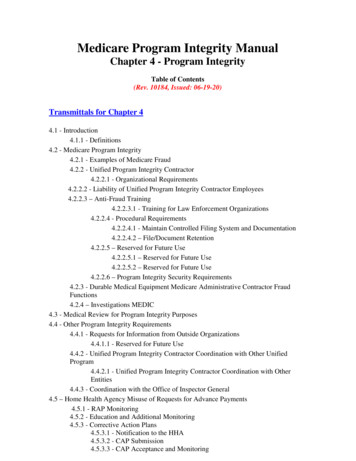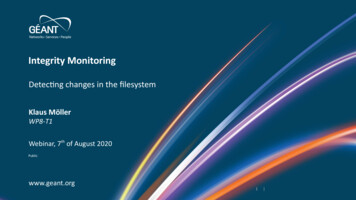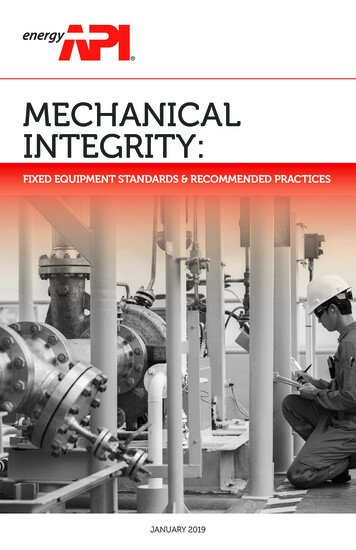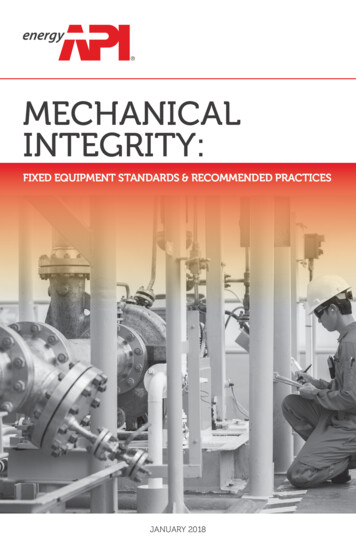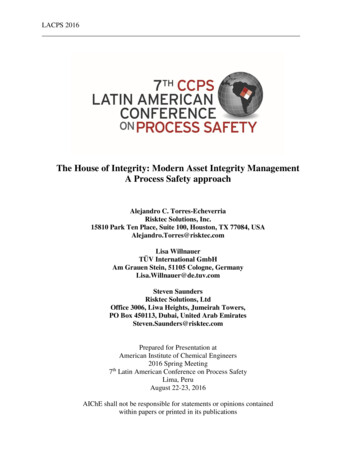
Transcription
LACPS 2016The House of Integrity: Modern Asset Integrity ManagementA Process Safety approachAlejandro C. Torres-EcheverriaRisktec Solutions, Inc.15810 Park Ten Place, Suite 100, Houston, TX 77084, USAAlejandro.Torres@risktec.comLisa WillnauerTÜV International GmbHAm Grauen Stein, 51105 Cologne, GermanyLisa.Willnauer@de.tuv.comSteven SaundersRisktec Solutions, LtdOffice 3006, Liwa Heights, Jumeirah Towers,PO Box 450113, Dubai, United Arab EmiratesSteven.Saunders@risktec.comPrepared for Presentation atAmerican Institute of Chemical Engineers2016 Spring Meeting7th Latin American Conference on Process SafetyLima, PeruAugust 22-23, 2016AIChE shall not be responsible for statements or opinions containedwithin papers or printed in its publications
LACPS 2016The House of Integrity: Modern Asset Integrity ManagementA Process Safety approachAlejandro Torres-EcheverriaRisktec Solutions, Inc.15810 Park Ten Place, Suite 100, Houston, TX 77084, USAAlejandro.Torres@risktec.comLisa WillnauerTÜV International GmbHAm Grauen Stein, 51105 Cologne, GermanyLisa.Willnauer@de.tuv.comSteven SaundersRisktec Solutions, LtdOffice 3006, Liwa Heights, Jumeirah Towers,PO Box 450113, Dubai, United Arab EmiratesSteven.Saunders@risktec.comKeywords: Asset integrity, integrity management, process safety management, reliability,maintenance, inspection.AbstractPhysical Asset Integrity Management (AIM) is a widely known and well-defined process that, ifapplied in the correct way, can offer asset owners and operators the ability to manage risk andassure the integrity of assets throughout their life cycle. The purpose of physical AIM is for anorganization to be able to assert, with confidence and based on the evidence, that their assets aresafe and reliable.The foundation required to build a robust approach to AIM starts with using recognizedinternational standards. ISO 55000 series of standards (formerly PAS 55) sets out good practicerequirements for managing physical assets and ensures that consistent terminology is applied.From this foundation an AIM “house” can be built.This paper introduces a model called the “Asset Integrity Management House”. The approachpresented here intends to bring together under one roof the disciplines of process safety andphysical asset integrity management, supported on reliability foundations, to facilitate therealization of common goals. This is physical asset management focused on risk managementtowards the reduction of major incident risks.
LACPS 2016The model sub-divides into three floors: 1) Physical AIM system. The top floor comprises thesystem of policies, standards, procedures and resources needed to be in place to deliver integrityover the whole life cycle of an asset. 2) Integrity, reliability and process safety assessment. Themiddle floor is about conducting the relevant analyses to ensure that integrity risks are understood,the assets are designed and operated to achieve their performance targets, and safety risks are aslow as reasonably practicable. 3) Maintenance, inspection and testing. At the ground floor levelare the activities which maintain the design intent through life. Spanning all floors is thecompetence of personnel in performing their tasks to the required standards.The benefits of such an encompassing simplified model is that each of the different disciplinesinvolved can identify the contribution they are making, and align their processes and work towardsachieving a common goal.1 The need for an integrated model between asset management and processsafety managementAsset Integrity can be defined as “the ability of an asset to perform its required functioneffectively and efficiently whilst protecting health, safety and the environment” [1]. AssetIntegrity Management (AIM) offers asset owners and operators the ability to manage risks andassure the integrity of assets throughout their life cycle. The purpose of AIM is to provide anorganization a system that ensures consistent and safe performance, being able to keep theirassets safe and reliable. PAS 55 [2], which has now evolved into ISO 55001 [3], is aninternational standard that establishes guidance for management of physical assets. ISO 55001 isactually applicable to any type of assets, although it is intended to be used specifically formanaging physical assets.High hazard industries must maintain a focus on risk management towards reducing the risk ofmajor incidents. OGP 415 [4] is a previous attempt to provide sound guidance in reduction ofmajor incidents risk by focusing on asset integrity management. Reduction of major incidentshazards is actually the main objective of the process safety discipline. Nevertheless, disciplinessuch as process safety and integrity management are still being treated separately inside manyorganizations. Reliability, maintenance (these two being fundaments of integrity management),and safety are still being managed as “silos” in some organizations. Silo mentality is an attitudethat dominates organizations where different departments do not share information nor worktogether with other departments of the same organization, which tampers the efforts forachieving common goals in an efficient and cost-effective manner.The approach presented here brings together under one roof the disciplines of process safety andphysical asset integrity management, supported on reliability foundations. This is physical assetmanagement focused on risk management towards the reduction of major incident risks. This iscalled the “Asset Integrity Management House”.It is worthy to make a distinction between occupational (or personal) safety and process safety.Occupational health and safety is mostly focused on high frequency “low” consequence events(e.g. occupational injuries, like slips, trips, and falls), while process safety is focused on lowfrequency high consequence events (e.g. those that can have catastrophic consequence, like wide
LACPS 2016reaching or multiple fatalities; i.e. major incidents). As OGP 415 states, “good occupationalhealth and safety performance of an asset does not guarantee major incident prevention” [4].2 The Plan-Do-Check-Act continuous improvement processThe basis of most modern management systems, such as quality (ISO 9001 [5]), environment(ISO 14001 [6]), occupational health & safety (OHSAS 18001 [7]), and risk management (ISO31000 [8]), are founded on a standard iterative continuous improvement management cycle:Plan, Do, Check, Act. Thus, most management systems share a common structure. Asestablished by HSG 65 [9]: Plan. Development of a policy and plans for implementation.Do. Implementation and execution of the plan with adequate resources.Check. Review and measurement of performance.Act. Taking action to act on deviations identified and lessons learned3 The different approaches and elements3.1. The approach for process safetyThe main focus or process safety is the prevention and control of hazards that have the potentialfor causing major incidents. Major hazards are those with the potential to cause multiplefatalities, catastrophic environmental damage or significant asset loss (i.e. low frequency, highconsequence events). Although process safety pertains to the process industry, its principles,methods and techniques can be applied to a wide spectrum of different high-hazard and otherindustries.Process safety-focused management has become an important aspect of loss prevention in theprocess industry worldwide. Example of important related regulations are the Seveso IIIDirective (implemented as the COMAH Regulations in the UK [10]), and the OSHA PSMregulation in the United States [11] (which precursor was API 750 [12]). Many other countrieshave followed implementing their own process safety regulations. Modern process safetymanagement is supported by an overall risk-based strategy founded on a series of differentelements (e.g. hazard identification, competence, management of change, etc.) that intend toimplement the four main pillars for process safety: commitment to process safety, understandingof hazards and risks, management of risks, and learning from experience. This approach has beencalled “risk based process safety” (as published by the Center for Chemical Process Safety [13]).A more recent approach has been published by the Energy Institute (EI) as a high levelframework for PSM [14]. The four focus areas of this approach are: Process safety leadership,risk identification and assessment, risk management, and review and improvement. Both theCCPS’ and EI’s schemes share important similarities.As discussed above, “good occupational health and safety performance of an asset does notguarantee good major incident prevention” [4]. Even if organizations focus on managingsuccessfully personal safety, they may still experience major accidents. This is supported, for
LACPS 2016example, by the Baker Report with reference to the Texas City accident when stated as one of itsfindings that “BP mistakenly used improving personal safety performance (i.e. personal injuryrates) as an indication of acceptable process safety performance at its five U.S. refineries; BP’sreliance on this data and inadequate process safety understanding created a false sense ofconfidence that it was properly addressing process safety risks at those refineries” [15].3.2. Risk ManagementISO 31000 [8] provides guidelines for a consistent risk management process, helpful to managerisks effectively and efficiently. This is an international standard which guidance can beimplemented for any type of risks (financial, strategic, etc.), and it sets out well principles thatcan be used for major hazards risk management. In addition to the Plan-do-check-act principle, itestablishes a risk assessment process that is at the core of the risk management implementation(the “”do” step). This is illustrated in Figure 1.The process safety risk management process is composed of: establishing the context, riskassessment and risk treatment. Risk assessment consists of performing identification of hazards,followed by a risk analysis (determining the likelihood and consequence of each hazard), andthen risk evaluation (comparing the actual risk against corporate risk criteria to determine if thisis tolerable or it needs to be further reduced). This makes possible to identify and implement riskcontrol (treatment) measures.Establishing the entRiskAssessmentRisk identificationRisk analysisRisk evaluationMonitoring andreviewRisk treatmentFRAMEWORKPROCESSFigure 1. Risk Management framework and process [8]Monitoring and reviewDesign offramework formanaging riskCommunication and consultationMandate andcommitement
LACPS 20163.3. Safety critical equipment and performance standards (OGP 415)A barrier is defined as a functional grouping of safeguards to prevent and control the realizationof a hazard [4]. Since barriers can be any measure implemented to support this function, a barriercan be a mix of tangible goods (e.g. equipment) and processes (procedures). Barriers can bepreventive (to prevent a hazardous event from taking place), or mitigative (to mitigate theconsequences of a hazardous event). Management of hazards is focused on the implementationof barriers for prevention and mitigation.The interpolation between physical asset management and management of major hazards isrealized when certain physical assets become barriers that serve in prevention and control ofhazards. Those physical barriers that are critical for safety can be classified as Safety CriticalEquipment (SCE). SCE needs to have their performance standards defined in terms offunctionality, availability, reliability and survivability [4]. The performance standards determinedesign specifications and maintenance requirements to maintain their required functionality andintegrity throughout their useful life.3.4. Mechanical integrity and reliabilityIt becomes clear thus that reliability is at the core of SCE performance standards. Notice thathere “reliability” refers to the discipline in charge of analysis and application of techniques tomaintain equipment and systems (in this case SCE) performing their intended function and freeof failure. Traditionally, mechanical integrity has been a subset of a company’s reliabilityprogram, encompassing measures and activities intended to ensure the integrity of mechanicalequipment through its lifecycle: design, fabrication, installation and operation (mechanicalintegrity is actually one of the elements of the OSHA PSM regulation [11]). The concept hasevolved to encompass all types of critical equipment (not only mechanical), becoming “processand equipment integrity”, and subsequently “asset integrity” [13]. This concept of asset integrityprimarily involves inspections, tests, preventive and predictive maintenance, repair activities andquality assurance processes to maintain SCEs fit for use.3.5. The asset integrity management approach (PAS 55 and ISO 55001)PAS 55 Asset Management [2] is the standard for the optimized management of physical assets.PAS 55 introduced a risk-based management approach for asset integrity, by putting riskassessment and management at the center of the program. Also, notice that several otherelements of the asset management structure overlap with those of process safety management;i.e. risk assessment, management of change, incident investigation, etc. Two of the principles ofrisk management set by PAS 55 are that is has to be 1) risk based, and 2) integrated. PAS alsointroduced the concept of “critical assets” as those “having the greatest potential to impact on theachievement of the organizational strategic plan”. In an interpolation with process safety, assetsthat are crucial for avoidance of major hazards can be classified as SCEs.
LACPS 2016Some of the most relevant contributions of PAS 55 were: It structured physical asset management into a standard management system, following theplan-do-check-act principle.Establishes as an essential attribute of physical asset management to be risk-based.Called for physical asset management to be integrated.Introduced several elements that can be easily overlapped with process safety managementsystems (i.e. the CCPS risk-based process safety [13], or the EI framework on PSM [14]programs) into the physical asset management system; such as risk identification andassessment, contingency planning, training and competence, management of change,physical asset monitoring, audit and management review.ISO 55001 [3] is the newest international standard for asset management. It is an evolution ofPAS 55 (which was actually phased out after the release of ISO 55001). ISO 55001 scope wasmade wider in comparison with PAS 55, and it is applicable to any type of assets (financial,human, information, etc.), although it is intended to be used mainly for managing physical assets.This wider scope makes its requirements to be more generic. As a result, ISO 55001 addressesrisk management with less detail than PAS 55, which guidance was more specific. Regardingrisk management, ISO 55001 only requires to determine “actions to address risks andopportunities”, with identification and assessment of risks, and to include them into riskmanagement and contingency planning. It actually refers the reader to “see ISO 31000 for furtherguidance on risk management”. Thus, ISO 55001 rather than establishing detailed requirementsfor the risk management process defers them to the use of ISO 31000, although following ISO31000 is not made mandatory. It can be said that ISO 55001 is the latest and currently validapproach for asset management, but PAS 55 is still a very useful reference for physical assetmanagement, and it can be used as a complement.3.6. Correspondence between different approachesTable 1 presents the correspondence between ISO 55001, PAS 55 and the CCPS’ and the EI’sprocess safety management approaches. The table demonstrates how risk-based process safetyelements overlap with ISO 55001/PAS 55 physical asset management systems. This is where theintegration of physical asset management and process safety can be accomplished; i.e. putting inplace a physical asset management system with a focus on major incident risks reduction.
LACPS 2016Table 1. Correspondence ISO 55001/PAS 55 to the CCPS Risk Based Process Safety and the EI Process Safety ManagementISO 55001Section4. Context of theorganization5. LedearshipPAS 55Element4.1. Understanding theorganization and its context4.2. Understanding the needs andexpectations of stakeholdersElement4.3.1. AM strategy4.3. Determining the scope of theAM system4.4. AM system4.1. General requirements5.1. Leadership and commitment4.4.1. Structure, authorityand responsibilities4.2. AM policy6. Planning7.1. Resources7.2. CompetenceEI PSMElementElement5. Communication via stakeholders4.1. General requirements1. Leadership commitement andresponsibility4.4.1. Structure, authorityand responsibilities4.3.3. AM plans6.2.1. AM objectives4.3.2. AM objectives6.2.2. Planning to achieve AMobjectives4.3.3. AM plansLoosely implicit in 6.2.2,referred to ISO 31000Loosely implicit in 6.2.2,referred to ISO 31000Mentioned in 6.2.2 ( lessdetailed than PAS55),referred to ISO 310004.4.7.4. Use and maintenace Loosely mentioned in 6.2.2,of asset risk informationreferred to ISO 310007. SupportCCPS RBPS5. Stakeholder outreach5.2. Policy5.3. Organizational roles,responsibilities and authorities6.1.Actions to address risk andopportunities for the AMS6.2. AM objectives and planningNotesLoosely mentioned in ISO55002 4.1.14.4.7.1. Risk managementprocess4.4.7.2. Risk managementmethodology4.4.7.3. Risk identificationand assessment7. Hazard identification and riskanalysis6. Hazard identification and riskassessment4.3.4. Contingency planning Loosely mentioned in 6.2.216. Emergency management14. Emergency preparedness3. Process safety competency3. Employee selection, placementand competency, and healthassurance4.5.2. Tools, facilites andequipment4.4.3. Training, awarenessand competence4.4.3. Training, awarenessand competence12. Training and performanceassurance7.3. Awareness7.4. Communication7.5. Information requirementsAM Asset Management4.4.3. Training, awarenessand competence4.4.4. Communication,participation andconsultation4.4.6. Informationmanagement4. Workforce involvement4. Workforce involvement5. Stakeholder outreach5. Communication via stakeholders6. Process knowledgemanagement7. Documentation, records andknowledge management
LACPS 2016Table 1. [Continuation]ISO 55001Section8. OperationElement7.6. Documented information8.1. Operational planning andcontrolPAS 557.6.1. Documentedinformation - generalElement4.4.5. AM systemdocumentation7.6.2. Creating and updatingdocumented information4.4.5. AM systemdocumentation7.6.3. Control of documentedinformation4.4.5. AM systemdocumentationCCPS RBPSNotes4.5.1. Lifecycle activities(very loosely)Element6. Process knowledgemanagement14. Operational readiness15. Conduct of operations10. Improvement8. Operating manuals andprocedures17. Work control, permit to workand task risk management9. Process and operational statusmonitoring, and handover13. Operational readiness andprocess startup10. Management of operationalinterfaces12. Management of change andproject management18. Contactor and supplierselection and management15. Inspection and maintenance13. Management of change9.1. Monitoring, measurement,analysis and evaluation9.2. Internal audit4.4.9. Management ofchange4.4.2. Outsorcing of AMactivities4.6.1. Performance andcondition monitoring4.6.4. Audit19. Auditing20. Audit, assurance, managementreview and intervention9.3. Management review4.7. Management review20. Management review andcontinuous improvement20. Audit, assurance, managementreview and intervention10.1. Nonconformity andcorrective action10.2. Preventive action4.6.5.1. Corrective andpreventative action4.6.5.1. Corrective andpreventative action4.6.5.2. Continualimprovement4.4.8. Legal and otherrequirements10. Asset integrity and reliability15. Inspection and maintenance10. Asset integrity and reliability15. Inspection and maintenance8.3. Outsorcing9. PerformanceevaluationElement7. Documentation, records andknowledge management8. Operating procedures9. Safe work practices8.2. Management of changeEI PSM10.3. Continual improvement11. Contractor management18. Measurement and metricsReferences scattered inseveral clauses in ISO 550014.6.2. Investigation of asset- Subjectively suggested inrelated failures, incidentsISO 55001 clause 10.1 (someand nonconformitiesguidance in ISO 5500210.1.20)4.6.3. Evaluation ofLoosely scattered in severalcomplianceclauses in ISO 550014.6.6. Records20. Management review andcontinuous improvement2. Compliance withstandandards17. Incident investigation2. Identification and compliancewith legislation and industrystandards19. Incident reporting andinvestigationNot covered explicitly,although can be implicit inISO 55001 clause 7.6.31. Process safety culture16. Management of safety criticaldevicesAM Asset Management
LACPS 20164 Integration of the modelThis section presents the integration of the different approaches and elements into one singlePhysical Asset Integrity model named the “Asset Integrity Management House”, which isillustrated in Figure 2. The model is sub-divided into three floors, described in the next subsections. The model integrates under one roof the disciplines of physical asset integrity andprocess safety management, supported on reliability foundations, and it is developed down toelementary methodologies and techniques that facilitate its successful implementation.Physical Asset IntegrityIntegrated Physical AIM SystemAsset IntegrityManagement SystemProcess SafetyManagement ProgramReview and ContinousImprovementIntegrity, Reliability & Process Safety AssessmentIntegrity AssessmentReliability ManagementFFSRAMCPCFALTERCMRBIFS/SILHazard Analysis &Risk AssessmentPHA LOPA CA/PEM QRASafety Case AnalysisALARPSCE/PSKPIAIM CompetenceAsset Integrity Policy,Strategy and LeadershipPerformance AssuranceMaintenanceInspectionTestingData Analysis &PerformanceImprovementFFS – Fitness for ServiceRAM – Reliability, Availability and Maintainability PHA – Process Hazard AnalysisALARP – As Low As Reasonably PracticalCPC – Corrosion Prevention and ControlRCM – Reliability Centered MaintenanceLOPA – Layer of Protection AnalysisFA – Failure AnalysisRBI – Risk Based InspectionLTE – Lifetim e ExtensionFS/SIL – Functional Safety / Safety IntegrityLevelCA/PEM – Consequence Analysis/ Physical Effects ModelingQRA – Quantitativ e Risk AnalysisSCE/PS – Safety Critical Equipment /Performance StandardsKPI – Key Performance IndicatorsFigure 2. The Physical Asset Integrity Management House4.1. Integrated Physical AIM SystemThe first level of the model is composed of four components. The two key components are theAsset Integrity management system and the Process Safety management system. Bothmanagement systems are integrated, especially in the elements where they converge (i.e. wheresome elements of ISO 55001/PAS 55 overlap those of the CCPS Risk Based Process Safetyand/or the EI Process Safety Management programs, as per Table 1). The other two components:
LACPS 2016Asset integrity policy, strategy and leadership, and Review and continuous improvement arefoundations over which those two management systems are implemented. “Using an integratedmanagement systems approach allows a management system to be built on elements of othermanagement systems, such as for quality, environment, health and safety, and risk management.This can improve integration across different disciplines and improve cross-functionalcoordination” [16].a) Asset Integrity policy, strategy and leadership. A policy is a high level document thatestablishes the organization’s intentions and direction. A strategy is a plan of action directedtowards achievement of the organization goals and objectives. This needs to be aligned withthe organization’s strategic plan [2]. Finally, leadership is essential to steer the organizationtowards successful implementation of the management system and achievement of itsobjectives. It sets commitment and accountability of directors and managers, which arecritical for success of any safety management system, and facilitates involvement at all levelsof the organization. Leadership is the foundation of an adequate safety culture within anorganization, since “top management should create the vision and values that guide policy,practice and actively promote these values inside and outside the organization” [17].b) Asset Integrity management system. It is the combination of policy, strategy, objectives,plans, activities, processes and organizational structures needed for the implementation andsustenance of the integrity of the organization’s assets [2]. In the context of this paper, it isbased on ISO 55001 [3] and PAS 55 [2], supported by ISO 31000 [8].c) Process Safety management (PSM) program. The PSM program integrates managementpractices, procedures and technologies intended to prevent or minimize the consequences ofcatastrophic incidents related to the release of toxic, reactive, flammable or explosivechemicals. In the context of this paper, is based on the PSM framework set by CCPS [13] andIE [14].d) Review and continuous improvement. These implement the CCPS’ “learn from experience”pillar [13]. It is basically the measurement and performance assessment of the managementsystem and the physical assets themselves, with the aim of implementing continuousimprovement. It includes elements such as incident investigation, performance metrics, audit,management review, and continuous improvement.4.2. Integrity, Reliability & Process Safety Assessmente) Integrity Assessment. This part provides the assessment and follow up of processestraditionally assigned to physical asset integrity management. Traditionally these processespertained to mechanical integrity, but have evolved to encompass all types of physical assets.o Fitness for Service – FSS. A FFS assessment is a quantitative evaluation performed toevaluate the structural integrity of a piece of equipment or a component that is inservice and which is sustaining a flaw or damage. Guidance can be found in API 579[18]. FFS assessments can encompass several damage mechanisms, such as fracture,fatigue, cracks, corrosion, etc.
LACPS 2016o Corrosion Prevention and Control – CPC. Corrosion is the deterioration of material orits properties due reaction with its chemical environment. A CPC program includesactivities for prevention and control of corrosion, and it can encompass all phases ofthe lifecycle. It applies management principles, engineering design and analysis,quality assurance, technologies and processes for tracking, control and repair ofcorrosion problems [19]. This may include for example materials selection,protective coating, inhibitors, environmental control, corrosion allowances andcathodic protection. In the operation phase this includes corrosion monitoring andcontrol measures.o Failure Analysis – FA. Failure relates to loss of functionality, which can be gradual orsudden. Failure analysis is the process of examination of a failed system orcomponent, using engineering data collection and analysis techniques, to determinethe damage mechanisms and the immediate and root causes of a failure. Failureanalysis can range from a simple desktop analysis to a comprehensive failureinvestigation. Some of the specialized techniques that can be used are Failure Modesand Effect Analysis (FMEA), Fault Tree Analysis, and other multiple testing andforensic engineering techniques. Failure Analysis is part of the “learning fromexperience” pillar, and can be a part of the incident investigation element. Resultsfrom failure analysis are used for prevention of further failures and control of failureconsequences.o Lifetime Extension – LTE. This is a program that can be implemented to extend thelife of ageing assets (equipment and facilities) beyond the original design expectedlifetime. Lifetime extension is based on a rigorous condition assessment and gapanalysis of regulatory requirements [20], and subsequent periodic monitoring, reviewand evaluation (integrity, functionality, performance, safety). Lifetime extensiondecisions for safety critical equipment needs to be based on an adequate riskassessment (see [21]).f) Reliability management. This deals with assessment, monitoring and assurance of assetdependability. Reliability is a wide concept that can be sometimes confusing. Here theconcept refers to the discipline of reliability engineering. Reliability of an asset can bequantified using several measures, one of them is actually called “reliability”. Thus, theconcept of dependability can be used as a collective term to describe an asset’s attributes ofreliability, availability and maintainability (RAM), i.e. the “trustworthiness” of an asset tokeep delivering its service free of failure.o Reliability, Availability, Maintainability – RAM. RAM analysis can encompassseveral different types of studies to determine system dependability. In its morecommon form it is actually a study of system availability. Reliability is theprobability of a system keeping performing its intended function (i.e. to stay free offailure) during a specific period of time. Maintainability is the probability of a systembeing repairable (at a given time). Availability is a measure that combines reliabilityand maintainability, to quantify the probability of a system being capable ofperforming its intended function (i.e. to be available) at a given time. For example, asystem may be free of failure (reliable) but unavailable due to maintenance. Thus,
LACPS 2016availability quantifies all time down (either by failure or by maintenance) to predictthe fraction of time that the system will be running.o Reliability Centered Maintenance
and equipment integrity", and subsequently "asset integrity" [13]. This concept of asset integrity primarily involves inspections, tests, preventive and predictive maintenance, repair activities and quality assurance processes to maintain SCEs fit for use. 3.5. The asset integrity management approach (PAS 55 and ISO 55001) PAS 55 Asset .


